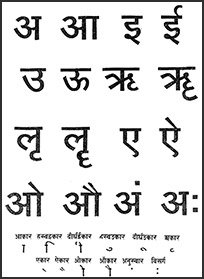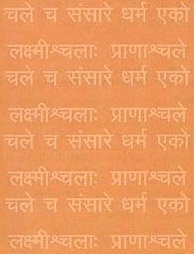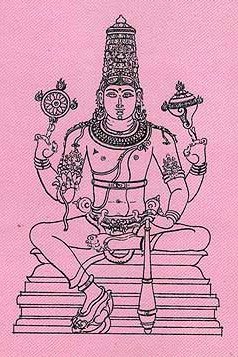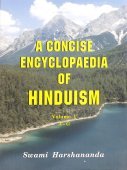Adrishta, Adṛṣṭa: 22 definitions
Introduction:
Adrishta means something in Buddhism, Pali, Hinduism, Sanskrit, Marathi, Hindi. If you want to know the exact meaning, history, etymology or English translation of this term then check out the descriptions on this page. Add your comment or reference to a book if you want to contribute to this summary article.
The Sanskrit term Adṛṣṭa can be transliterated into English as Adrsta or Adrishta, using the IAST transliteration scheme (?).
Alternative spellings of this word include Adrasht.
In Hinduism
Vyakarana (Sanskrit grammar)
Source: Wikisource: A dictionary of Sanskrit grammarAdṛṣṭa (अदृष्ट).—Not seen properly; doubtful; indistinct;said with respect to a letter which is not distinctly deciphered in the Saṃhitāpātha: e.g. तन्नः (tannaḥ) (R. Saṃh. I. 107. 3): the last letter त् (t) of तत् (tat) is deciphered in the Pada-pātha which is given as तत्-नः (tat-naḥ) cf. अदृष्टवर्णे प्रथमे चोदकः स्यात् प्रदर्शकः (adṛṣṭavarṇe prathame codakaḥ syāt pradarśakaḥ) R. Pr. X. 15.

Vyakarana (व्याकरण, vyākaraṇa) refers to Sanskrit grammar and represents one of the six additional sciences (vedanga) to be studied along with the Vedas. Vyakarana concerns itself with the rules of Sanskrit grammar and linguistic analysis in order to establish the correct context of words and sentences.
Shilpashastra (iconography)
Source: Shodhganga: The significance of the mūla-beras (śilpa)Adṛṣṭa (अदृष्ट) refers to the “unseen world”.—In Indian sculpture, painting, and iconography, the majority of the figures are based on the human body. This belongs to the dṛṣṭa (the visible world). All natural shapes are said to be with life. Human body is the place where the outer world is transformed. It is also the scene of the transformation of the self. In this transformed shape, the self is represented in art. The transformation results from an inner process of realization. It is not visible to the physical eye; it belongs to the adṛṣṭa (the unseen). The world of the inner reality differs from the outer world but cannot exist without it. Therefore, art serves as the meeting ground of the two worlds and relates to the transformation of the inner world to that of the outer.

Shilpashastra (शिल्पशास्त्र, śilpaśāstra) represents the ancient Indian science (shastra) of creative arts (shilpa) such as sculpture, iconography and painting. Closely related to Vastushastra (architecture), they often share the same literature.
Vedanta (school of philosophy)
Source: Shodhganga: Siva Gita A Critical StudyAdṛṣṭa (अदृष्ट) refers to “unforeseen, not observed or thought of”.—Virtue or vice as the eventual cause of pleasure or pain.

Vedanta (वेदान्त, vedānta) refers to a school of orthodox Hindu philosophy (astika), drawing its subject-matter from the Upanishads. There are a number of sub-schools of Vedanta, however all of them expound on the basic teaching of the ultimate reality (brahman) and liberation (moksha) of the individual soul (atman).
Ayurveda (science of life)
Source: gurumukhi.ru: Ayurveda glossary of termsAdṛṣṭa (अदृष्ट):—[adṛṣṭam] The invisible result of works done in former states of embodied existence ; an unseen consequences of an act.

Āyurveda (आयुर्वेद, ayurveda) is a branch of Indian science dealing with medicine, herbalism, taxology, anatomy, surgery, alchemy and related topics. Traditional practice of Āyurveda in ancient India dates back to at least the first millenium BC. Literature is commonly written in Sanskrit using various poetic metres.
Shaktism (Shakta philosophy)
Source: Google Books: Manthanabhairavatantram1) Adṛṣṭa (अदृष्ट) refers to “invisible” and is used to describe the Goddess, according to the second recension of the Yogakhaṇḍa of the Manthānabhairavatantra, a vast sprawling work that belongs to a corpus of Tantric texts concerned with the worship of the goddess Kubjikā.—Accordingly, as Śrīkaṇṭha praised the Goddess: “Victory! Victory (to you who are) in the middle of the Liṅga of the Void (khaliṅga), invisible [i.e., adṛṣṭa-vigraha], (you who are) Light and (whose) form is the Supreme Void (ākāśa), worshipped with great devotion. I have come (to take) refuge (in you) O mistress (svāminī), have mercy on me. [...]”.
2) Adṛṣṭa (अदृष्ट) refers to the “invisible” (body of bliss), according to the Ciñcinīmatasārasamuccaya verse 1.34-37.—Accordingly, “Khecarī clearly manifest is the letter called Without Name (anāmā). (She is) Vāgbhava (AIṂ) (that contains) the series of letters from A to KṢa in the form of sleeping serpent. Radiant like the Wish-granting Gem, it is the expanse (vistara) that is Kula Bhairava. It is the Place (sthāna), the divine inner Place that is one’s own place (svasthāna) present on the earth. It is bliss whose body is invisible (adṛṣṭa). The pure transcendent tradition (anvaya). O goddess, this is the teaching concerning the transmission of the Divine Current”.

Shakta (शाक्त, śākta) or Shaktism (śāktism) represents a tradition of Hinduism where the Goddess (Devi) is revered and worshipped. Shakta literature includes a range of scriptures, including various Agamas and Tantras, although its roots may be traced back to the Vedas.
Shaivism (Shaiva philosophy)
Source: Brill: Śaivism and the Tantric Traditions (philosophy)Adṛṣṭa (अदृष्ट) refers to “unperceived (reality)”, according to Utpaladeva’s Vivṛti on Īśvarapratyabhijñākārikā 1.5.6.—Accordingly, “To begin with, as far as agents of ordinary human practice are concerned, it is on [the basis of] mere phenomena that [they] manage to an ascertainment in which [they necessarily] engage [in their ordinary activities]; so this pondering over an unperceived reality (adṛṣṭa-vastu) that is [supposedly] something more [than phenomena and the consciousness manifesting them] is a [purely] arbitrary endeavour! [...]”.

Shaiva (शैव, śaiva) or Shaivism (śaivism) represents a tradition of Hinduism worshiping Shiva as the supreme being. Closely related to Shaktism, Shaiva literature includes a range of scriptures, including Tantras, while the root of this tradition may be traced back to the ancient Vedas.
Kavya (poetry)
Source: Brill: Śaivism and the Tantric Traditions (kavya)Adṛṣṭa (अदृष्ट) refers to “not having perceived (the truth)”, according to Kālidāsa’s Raghuvaṃśa verse 9.78.—Accordingly: “Therefore, although the sun may fall to earth, or Himālaya lose its fixity, I’ll not return home like a common man, whose senses yearn for sensual things, and who has not perceived the truth (adṛṣṭa-sattva)”.

Kavya (काव्य, kavya) refers to Sanskrit poetry, a popular ancient Indian tradition of literature. There have been many Sanskrit poets over the ages, hailing from ancient India and beyond. This topic includes mahakavya, or ‘epic poetry’ and natya, or ‘dramatic poetry’.
Pancaratra (worship of Nārāyaṇa)
Source: University of Vienna: Sudarśana's Worship at the Royal Court According to the AhirbudhnyasaṃhitāAdṛṣṭa (अदृष्ट) or Adṛṣṭārtha refers to “unseen (aims)”, according to the Ahirbudhnyasaṃhitā, belonging to the Pāñcarātra tradition which deals with theology, rituals, iconography, narrative mythology and others.—Accordingly, “For only the Court Officiant accomplishes for Kings all seen and unseen aims (adṛṣṭa-artha—dṛṣṭādṛṣṭārthasādhakaḥ), especially when this Deity is installed, worshipped and so on. Any defectiveness of his (i.e. of the King) is due to the faults of the Court Officiant, and similarly [every] excellence of the same King in [the performance of] rituals [depends on the Officiant], oh Master of the Earth!”.

Pancaratra (पाञ्चरात्र, pāñcarātra) represents a tradition of Hinduism where Narayana is revered and worshipped. Closeley related to Vaishnavism, the Pancaratra literature includes various Agamas and tantras incorporating many Vaishnava philosophies.
General definition (in Hinduism)
Source: Hindupedia: The Hindu EncyclopediaAdṛṣṭa literally means ‘the unseen’. Adṛṣṭa refers to the unseen power that guides human destiny. Success or failure depends on the consonance of this power with our efforts. This word is used in the sense of ‘karma’ or fate (the consequence of actions, good or bad, done in the previous lives). The word is sometimes used to indicate only merit, accruing to the performer of good deeds. Some schools use it in the sense of blind destiny.
The Purva-mīmāmsā system, however, employs it in a technical sense as equivalent to ‘apurva,’ the unseen effect of sacrificial rites producing the desired results for the performer in his future life.
Adṛṣṭa resides in the subtle body of the soul unfolding its results at the appropriate time in future or in future life. Its power is irresistible and incomprehensible by ordinary consciousness.
In Buddhism
Mahayana (major branch of Buddhism)
Source: academia.edu: A Study and Translation of the GaganagañjaparipṛcchāAdṛṣṭa (अदृष्ट) refers to “(that which was) not seen (before)”, according to the Gaganagañjaparipṛcchā: the eighth chapter of the Mahāsaṃnipāta (a collection of Mahāyāna Buddhist Sūtras).—Accordingly, “[The flowers] were adorned with their own splendor, produced by immeasurable merits, and known by Bodhisattvas of the ten directions. The great three-thousand thousands of worlds were covered with those flowers, and all congregations of the Lord were filled with flowers (puṣpa) up to their knees (jānumātra). Then the whole assembly, having seen the flowers which have never seen or heard before (adṛṣṭa-aśruta-pūrva), addressed themselves to the Lord: ‘O Lord, where are such beautiful flowers coming from?’.”.

Mahayana (महायान, mahāyāna) is a major branch of Buddhism focusing on the path of a Bodhisattva (spiritual aspirants/ enlightened beings). Extant literature is vast and primarely composed in the Sanskrit language. There are many sūtras of which some of the earliest are the various Prajñāpāramitā sūtras.
Languages of India and abroad
Marathi-English dictionary
Source: DDSA: The Molesworth Marathi and English Dictionaryadṛṣṭa (अदृष्ट).—n (S) Fortune, destiny, consequence or fruit of one's deeds. 2 (Because the fortunes or lot are supposed to be written on the forehead.) The forehead. 3 Virtue or vice as the source of eventual pleasure or pain. adṛṣṭāsa yēṇēṃ To seem proper or advisable unto.
Marathi is an Indo-European language having over 70 million native speakers people in (predominantly) Maharashtra India. Marathi, like many other Indo-Aryan languages, evolved from early forms of Prakrit, which itself is a subset of Sanskrit, one of the most ancient languages of the world.
Sanskrit dictionary
Source: DDSA: The practical Sanskrit-English dictionaryAdṛṣṭa (अदृष्ट).—a.
1) Invisible, not seen; °पूर्व (pūrva) not seen before.
2) Not known or experienced, not felt; °विरहव्यथम् (virahavyatham) H.1.125.
3) Unforeseen, not observed or thought of; unknown, unobserved. तस्माददृष्टं त्वां भयमागमिष्यति (tasmādadṛṣṭaṃ tvāṃ bhayamāgamiṣyati) Mahābhārata (Bombay) 1.3.9.
4) Not-permitted or sanctioned, illegal; न चादृष्टां (na cādṛṣṭāṃ) (vṛddhiṃ) पुनर्हरेत् (punarharet) Manusmṛti 8.153.
-ṣṭaḥ Name of some venomous substance or vermin.
-ṣṭam 1 The invisible one.
2) Destiny, fate, luck (good or bad); दैवमिति यदपि कथयसि पुरुषगुणः सोऽयदृष्टाख्यः (daivamiti yadapi kathayasi puruṣaguṇaḥ so'yadṛṣṭākhyaḥ) Pañcatantra (Bombay) 5.3.
3) Virtue or vice as the eventual cause of pleasure or pain. (Fate is supposed to be the result of good or bad actions done in one state of existence and experienced in another, the performance of good deeds being rewarded with residence in Heaven, and of bad deeds, visited with condemnation to Hell; dharmādharmāvadṛṣṭaṃ syāt dharmaḥ svargādi- sādhana...adharmo narakādīnāṃ heturninditakarmajaḥ Bhāṣā P.161-2. The Vedāntins do not recognize adṛṣṭa or luck; tairhi karmaṇaḥ sūkṣmāvasthāpannasaṃskāraviśeṣa eva adṛṣṭasthānīyatvenāṅgīkriyate; adṛṣṭam ātmadarma iti naiyāyikā vaiśeṣikādayaśca, sāṃkhyapātañjalāstu buddhidharma ityamyupagacchanti Tv.)
4) An unforeseen calamity or danger (such as from fire, water &c.)
Source: Cologne Digital Sanskrit Dictionaries: Shabda-Sagara Sanskrit-English DictionaryAdṛṣṭa (अदृष्ट).—n.
(-ṣṭaṃ) 1. Casual and unseen danger, (as from conflagration, inundation, &c.) 2. Fortune, destiny, fate. 3. (In logic) Virtue or vice, as the eventual cause of pleasure or pain. mfn.
(-ṣṭaḥ-ṣṭā-ṣṭaṃ) 1. Unseen, unforeseen. 2. Unknown, unfelt. not experienced. E. a neg. and dṛṣṭa seen.
Source: Cologne Digital Sanskrit Dictionaries: Cappeller Sanskrit-English DictionaryAdṛṣṭa (अदृष्ट).—[adjective] unseen, invisible, unforeseen, unexpected; unprecedented, unlawful; [neuter] the invisible power, fate, destiny.
--- OR ---
Adṛṣṭa (अदृष्ट).—[adjective] unseen, invisible, unforeseen, unexpected; unprecedented, unlawful; [neuter] the invisible power, fate, destiny.
Source: Cologne Digital Sanskrit Dictionaries: Monier-Williams Sanskrit-English Dictionary1) Adṛṣṭa (अदृष्ट):—[=a-dṛṣṭa] [from a-dṛś] mfn. or a-dṛṣṭa [Śatapatha-brāhmaṇa] unseen, unforeseen, invisible, not experienced, unobserved, unknown, unsanctioned
2) [v.s. ...] m. Name of a particular venomous substance or of a species of vermin, [Atharva-veda]
3) [v.s. ...] n. unforeseen danger or calamity, that which is beyond the reach of observation or consciousness, (especially the merit or demerit attaching to a man’s conduct in one state of existence and the corresponding reward or punishment with which he is visited in another)
4) [v.s. ...] destiny, fate: luck, bad luck.
Source: Cologne Digital Sanskrit Dictionaries: Goldstücker Sanskrit-English DictionaryAdṛṣṭa (अदृष्ट):—[tatpurusha compound] I. m. f. n.
(-ṣṭaḥ-ṣṭā-ṣṭam) 1) Unseen, unfore-seen.
2) Unknown, unfelt, not experienced.
3) Invisible. Ii. n.
(-ṣṭam) 1) Casual and unseen danger (as from conflagration, inundation &c.).
2) Fortune, destiny, fate.
3) (In philosophy.) [a.]) Virtue or vice (dharma or adharma), as the eventual cause of pleasure or pain. [b.]) The remote or unforeseen consequence of an act, e. g. heaven as that of religious rites &c. See apūrva. Iii. m.
(-ṣṭaḥ) A kind of poison or poisonous reptile (in the Vedas). E. a neg. and dṛṣṭa.
Source: Cologne Digital Sanskrit Dictionaries: Yates Sanskrit-English DictionaryAdṛṣṭa (अदृष्ट):—[a-dṛṣṭa] (ṣṭaṃ) 1. n. Casual danger; fate. a. Unseen, unknown.
Source: DDSA: Paia-sadda-mahannavo; a comprehensive Prakrit Hindi dictionary (S)Adṛṣṭa (अदृष्ट) in the Sanskrit language is related to the Prakrit words: Aiṭṭha, Adakkhu, Addiṭṭha.
[Sanskrit to German]
Sanskrit, also spelled संस्कृतम् (saṃskṛtam), is an ancient language of India commonly seen as the grandmother of the Indo-European language family (even English!). Closely allied with Prakrit and Pali, Sanskrit is more exhaustive in both grammar and terms and has the most extensive collection of literature in the world, greatly surpassing its sister-languages Greek and Latin.
Hindi dictionary
Source: DDSA: A practical Hindi-English dictionaryAdṛṣṭa (अदृष्ट) [Also spelled adrasht]:—(nm) fate, fortune; (a) unforeseen; ~[pūrva] unique, unprecedented; ~[vāda] fatalism; determinism; ~[vāditā] see ~[vāda]; ~[vādī] a fatalist, determinist; fatalistic, deterministie.
...
Kannada-English dictionary
Source: Alar: Kannada-English corpusAdṛṣṭa (ಅದೃಷ್ಟ):—[adjective] that cannot be seen; unseen; invisible.
--- OR ---
Adṛṣṭa (ಅದೃಷ್ಟ):—
1) [noun] the seemingly inevitable happening of events that affect someone; fortune or fate that cannot be predicted or foreseen.
2) [noun] good fortune; success, prosperity, advantage, etc. 3) the force believed to cause things, esp. good things, to happen to a person by chance and not as a result of his or her own efforts or abilities; destiny;3) [noun] ಅದೃಷ್ಟದ ಆಟ [adrishtada ata] adřṣṭada āṭa a game of chance, as gambling etc. 2. (fig.) the ups and downs in one’s life believed to have been caused by the destiny; ಅದೃಷ್ಟದ ಏಣಿ ಏರು [adrishtada eni eru] adřṣṭada ēṇi ēru (fig.) to achieve something or progress mainly by the luck of the draw; to have luck on one’s side; ಅದೃಷ್ಟ ಖುಲಾಯಿಸು [adrishta khulayisu] adřṣṭa khulāyisu (something good) to happen (usu. unexpectedly).
Kannada is a Dravidian language (as opposed to the Indo-European language family) mainly spoken in the southwestern region of India.
See also (Relevant definitions)
Starts with (+20): Adrishtabhaya, Adrishtadarshana, Adrishtaguna, Adrishtahan, Adrishtahina, Adrishtahine, Adrishtaja, Adrishtakalpana, Adrishtakama, Adrishtakarita, Adrishtakarman, Adrishtakharca, Adrishtanara, Adrishtaparasamarthya, Adrishtaparikshe, Adrishtaphala, Adrishtapurusha, Adrishtapurushasamdhi, Adrishtapurva, Adrishtapurvva.
Ends with (+4): Anadrishta, Anapayadrishta, Ayathadrishta, Ciradrishta, Deshadrishta, Dravyadrishta, Drishtadrishta, Duradrishta, Kshanadrishta, Kshananashtadrishta, Natadrishta, Pramanadrishta, Pratyakshadrishta, Puranadrishta, Purvadrishta, Purvvadrishta, Sahasadrishta, Shastradrishta, Shilpavidhanadrishta, Svadrishta.
Full-text (+30): Aittha, Adrishtapurva, Adrishtapurusha, Adakkhu, Duradrishta, Adrishtavat, Adrishtanara, Drishtadrishta, Adrishtaja, Adrishtarupa, Adrishya, Adrishtahan, Adrishtakarman, Adrishtaphala, Drishta, Adrishtartha, Adrishtaparasamarthya, Adrishtakama, Addittha, Atittacali.
Relevant text
Search found 63 books and stories containing Adrishta, Adṛṣṭa, Adrsta, A-drishta, A-dṛṣṭa, A-drsta; (plurals include: Adrishtas, Adṛṣṭas, Adrstas, drishtas, dṛṣṭas, drstas). You can also click to the full overview containing English textual excerpts. Below are direct links for the most relevant articles:
Vaisheshika-sutra with Commentary (by Nandalal Sinha)
Sūtra 5.1.15 (Action produced by adṛṣṭa) < [Chapter 1 - Of Voluntary Action]
Sūtra 5.2.13 (Causes of initial action of fire, air, atoms, and mind) < [Chapter 2 - Of Non-volitional Action]
Sūtra 6.2.12 (Above continued) < [Chapter 2 - Of the Production of Dharma and A-dharma]
Brahma Sutras (Shankaracharya) (by George Thibaut)
II, 3, 51 < [Second Adhyāya, Third Pāda]
II, 2, 14 < [Second Adhyāya, Second Pāda]
II, 3, 53 < [Second Adhyāya, Third Pāda]
Brahma Sutras (Shankara Bhashya) (by Swami Vireshwarananda)
Chapter II, Section III, Adhikarana XVII < [Section III]
Chapter II, Section II, Adhikarana III < [Section II]
Chapter II, Section II, Adhikarana II < [Section II]
The Tattvasangraha [with commentary] (by Ganganatha Jha)
Verse 1587 < [Chapter 19c - (C) On presumption (arthāpatti)]
Taittiriya Upanishad Bhashya Vartika (by R. Balasubramanian)
Verse 2.684 < [Book 2 - Brahmavallī]
Verse 2.498 < [Book 2 - Brahmavallī]
Verse 2.499 < [Book 2 - Brahmavallī]
A History of Indian Philosophy Volume 1 (by Surendranath Dasgupta)
Part 3 - Does Vaiśeṣika represent an Old School of Mīmāṃsā? < [Chapter VIII - The Nyāya-Vaiśeṣika Philosophy]
Part 11 - Dissolution (Pralaya) and Creation (Srṣṭi) < [Chapter VIII - The Nyāya-Vaiśeṣika Philosophy]
Part 7 - The nature of knowledge < [Chapter IX - Mīmāṃsā Philosophy]
Related products
